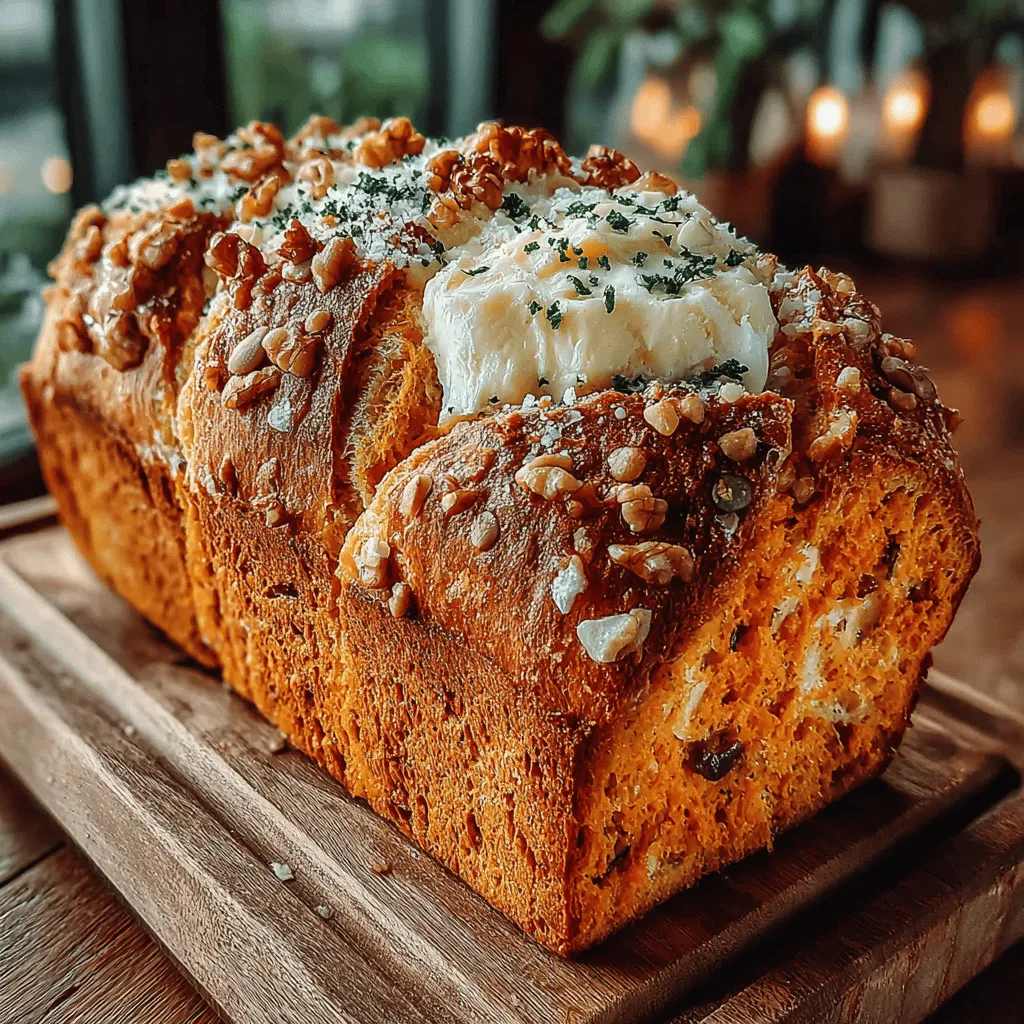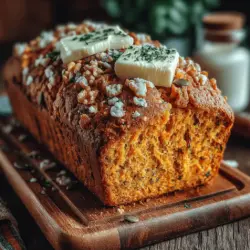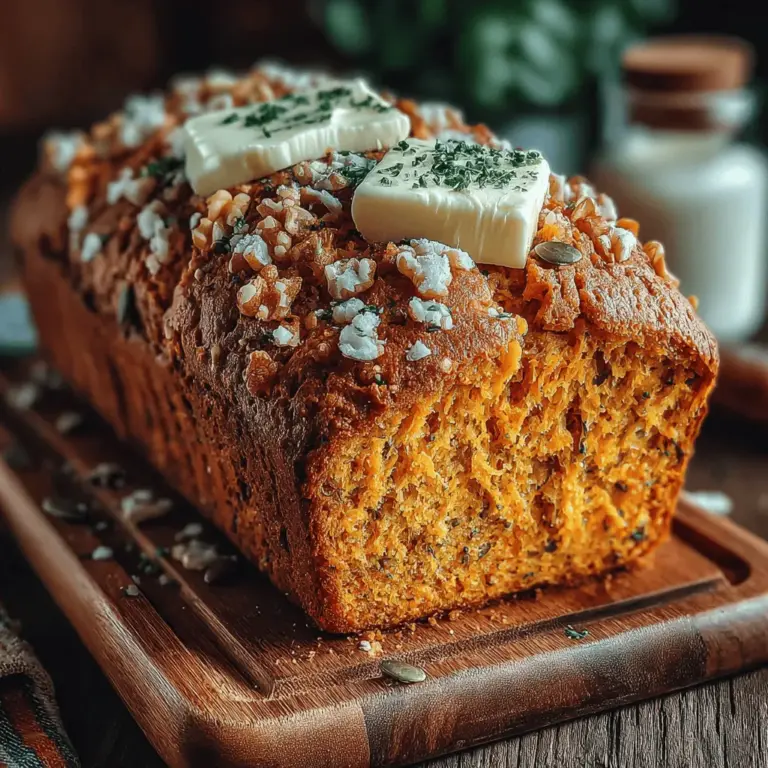Harvest Pumpkin & Walnut Spelt Bread Recipe
As the leaves begin to turn and the air takes on a crispness that signals the arrival of fall, there’s no better way to embrace the season than with a warm loaf of Harvest Pumpkin & Walnut Spelt Bread. This delightful recipe is not just a treat for the palate; it embodies the essence of autumn with its rich flavors and wholesome ingredients.
Pumpkin, a quintessential fall ingredient, adds a moist and tender texture to the bread while infusing it with a subtle sweetness. Coupled with the satisfying crunch of walnuts, this bread offers a perfect balance of flavors and textures. Not only is this recipe a celebration of seasonal produce, but it also serves as a nutritious alternative to traditional bread, making it a staple for health-conscious bakers.
The Seasonal Appeal of Pumpkin
Pumpkin is more than just a decorative element for Halloween; it’s a versatile and nutrient-rich ingredient that shines in various dishes. When incorporated into bread, pumpkin puree provides not only moisture but also a natural sweetness that reduces the need for added sugars. This makes it an ideal ingredient for those looking to indulge in delicious baked goods while keeping their diet balanced.
Health Benefits of Whole Spelt Flour and Walnuts
One of the standout features of this recipe is the use of whole spelt flour. Unlike regular all-purpose flour, spelt flour is an ancient grain that boasts a higher protein content and a wealth of nutrients. It is rich in fiber, which aids in digestion and helps maintain a feeling of fullness. Additionally, spelt flour contains essential vitamins and minerals such as magnesium, iron, and zinc, making it a healthier alternative for baking.
Walnuts, another key ingredient in this recipe, are a powerhouse of nutrition. They are packed with omega-3 fatty acids, which are known for their heart-healthy benefits, as well as protein and antioxidants. The inclusion of walnuts not only enhances the nutritional profile of the bread but also contributes a delightful crunch and a rich, nutty flavor that complements the sweetness of the pumpkin.
This cozy baking experience invites you to embrace the spirit of autumn while nourishing your body with wholesome ingredients. The aroma of baking bread, infused with warm spices and the earthy scent of walnuts, creates a comforting atmosphere that is perfect for enjoying with family and friends.
Understanding the Ingredients
Overview of Whole Spelt Flour
Whole spelt flour is milled from the ancient grain spelt, which has been cultivated for thousands of years. It is often considered more nutritious than regular wheat flour due to its higher protein and fiber content. This flour also has a slightly nutty flavor, which adds depth to baked goods.
Nutritional Benefits of Whole Spelt Flour
Whole spelt flour is a good source of dietary fiber, aiding in digestion and promoting a healthy gut. It also contains essential nutrients like B vitamins, magnesium, and phosphorus, which play vital roles in energy metabolism and bone health. Additionally, spelt is easier to digest for some individuals compared to regular wheat due to its unique gluten structure.
Differences from Regular Flour
Unlike all-purpose flour, which is often stripped of its nutrients during processing, whole spelt retains the bran and germ, making it a more wholesome choice. The protein in spelt flour tends to be more soluble, which can result in a lighter and fluffier bread. However, due to its unique properties, it may require slight adjustments in baking recipes, particularly when it comes to hydration levels.
Exploring Pumpkin Puree
Pumpkin puree is the star ingredient in this recipe, bringing both flavor and moisture to the bread. Using fresh pumpkin or canned pumpkin puree can enhance your baking, providing a taste of the season.
Nutritional Value and Health Benefits
Pumpkin is low in calories yet high in essential nutrients, including vitamin A, which supports eye health, and vitamin C, which boosts the immune system. It is also rich in potassium, which helps regulate blood pressure, and antioxidants that combat oxidative stress.
How it Enhances Flavor and Moisture
The natural sweetness of pumpkin puree allows for a reduction in added sugars, making it a healthier option for those who love baked goods. Furthermore, the moisture content in pumpkin ensures a tender crumb, preventing the bread from becoming dry or crumbly, making it perfect for toasting or enjoying on its own.
The Role of Walnuts in the Recipe
Walnuts not only add nutritional value but also texture and flavor to the Harvest Pumpkin & Walnut Spelt Bread. Their rich, buttery flavor complements the sweetness of the pumpkin, creating a harmonious balance.
Nutritional Benefits
Rich in omega-3 fatty acids, walnuts are known for their heart-healthy properties. They also provide a good source of protein and fiber, making this bread a satisfying and nutritious choice. Additionally, walnuts contain antioxidants that help reduce inflammation and support overall health.
How Walnuts Contribute to Texture and Flavor
The crunchiness of walnuts contrasts beautifully with the soft, dense texture of the pumpkin bread. Their nutty flavor enhances the overall taste, making each slice a delightful experience. Toasting the walnuts before adding them to the batter can further intensify their flavor, making them an irresistible addition to this recipe.
Sweeteners: Honey vs. Maple Syrup
Choosing the right sweetener can significantly affect the flavor and health aspects of your bread. In this recipe, you have the option of using honey or maple syrup, both of which bring their unique profiles to the table.
Flavor Profiles and Health Aspects
Honey offers a floral sweetness and has natural antibacterial properties, while maple syrup provides a rich, caramel-like flavor. Both options are less processed than refined sugars and come with their own set of health benefits. Honey is known for its soothing properties, while maple syrup is rich in antioxidants and contains vital minerals like manganese and zinc.
Choosing the Right Sweetener for Your Taste
When selecting a sweetener, consider your personal preference and dietary needs. Both honey and maple syrup can be used interchangeably in this recipe, allowing you to create a loaf that suits your taste buds. Adjust the amount based on how sweet you like your bread, keeping in mind that both options add moisture to the dough.
The Importance of Spices: Cinnamon, Nutmeg, and Cloves
No autumn bread is complete without the warm, inviting flavors of spices. In this recipe, cinnamon, nutmeg, and cloves play a crucial role in elevating the flavor profile.
Health Benefits of Spices
Spices like cinnamon are known for their anti-inflammatory properties and can help regulate blood sugar levels. Nutmeg has been linked to improved digestion and better sleep, while cloves are rich in antioxidants and can support oral health. Incorporating these spices into your baking not only enhances the flavor but also adds health benefits.
How Spices Elevate the Flavor Profile
The combination of these spices creates a warm, comforting aroma that is synonymous with fall baking. They complement the sweetness of the pumpkin and the richness of the walnuts, making each bite a delightful experience. Experimenting with the amount of spices allows you to customize the flavor to your liking, ensuring your Harvest Pumpkin & Walnut Spelt Bread is perfect for your palate.
Step-by-Step Instructions
Now that you have a deep understanding of the ingredients, it’s time to delve into the step-by-step instructions for creating your own Harvest Pumpkin & Walnut Spelt Bread. The process begins with activating the yeast, a crucial step in ensuring your bread rises to perfection.
Activating the Yeast: Importance and Tips
Explanation of the Yeast Activation Process
Yeast is a living organism that ferments sugars and produces carbon dioxide, which causes the bread to rise. Activating the yeast is essential for achieving a light and airy texture in your loaf. Typically, this involves dissolving the yeast in warm water with a bit of sugar to feed it and kickstart the fermentation process.
Signs of Properly Activated Yeast
You’ll know your yeast is activated when it becomes frothy and bubbly after about 5-10 minutes. If your yeast does not foam, it may be dead, and you should start over with fresh yeast to ensure your bread rises properly.
Mixing Dry Ingredients: Achieving the Right Consistency
Importance of Thorough Mixing
Once the yeast is activated, the next step is to mix the dry ingredients thoroughly. This ensures that the leavening agents, spices, and flour are evenly distributed throughout the batter, resulting in a uniform texture and flavor in the final product.
Tips for Measuring Flour Accurately
Accurate measurement of flour is crucial for the success of your bread. Use the spoon-and-level method: fluff up the flour with a spoon, then spoon it into your measuring cup without packing it down. Level off the top with a straight edge for precise measurement.
Combining Wet Ingredients: Creating the Base
Finally, it’s time to combine the wet ingredients, including the activated yeast mixture, pumpkin puree, and your chosen sweetener.
How to Achieve a Smooth Mixture
Whisk the wet ingredients together until smooth before incorporating them into the dry mixture. Ensuring a smooth, lump-free consistency is essential for achieving a uniform texture in the bread. Mixing the wet and dry ingredients until just combined will prevent over-mixing, which can lead to a dense loaf.
With these initial steps complete, you’re well on your way to creating a delicious Harvest Pumpkin & Walnut Spelt Bread that captures the essence of autumn in every bite. Stay tuned for the next part, where we will guide you through the remaining steps to ensure your baking experience is as enjoyable as the final result.

Importance of Using Unsweetened Pumpkin Puree
Using unsweetened pumpkin puree is crucial for achieving the perfect balance of flavors in your Harvest Pumpkin & Walnut Spelt Bread. This ingredient provides natural moisture and a subtly sweet flavor without overpowering the bread. Unsweetened pumpkin puree also enhances the bread’s nutritional profile, offering essential vitamins like A, C, and E, along with minerals such as potassium and magnesium. When selecting pumpkin puree, ensure it is pure with no added sugars or spices, allowing the natural flavors to shine through in every slice.
Forming and Kneading the Dough
Once your ingredients are combined, it’s time to form and knead the dough. Start by transferring the mixture to a well-floured surface. With clean hands, gently form the dough into a rough ball, ensuring that it holds together.
Recognizing the Right Dough Texture
The right dough texture is fundamental to successful bread baking. You want a dough that is slightly tacky but not overly sticky. If it clings to your hands too much, sprinkle a bit more flour onto the surface and your hands as you knead. The ideal dough should be smooth, elastic, and slightly springy when pressed.
Kneading Techniques for Optimal Gluten Development
Kneading is essential for developing gluten, which gives bread its structure and chewiness. To knead effectively, fold the dough in half toward you, then push it away with the heel of your hand. Rotate the dough a quarter turn and repeat this process. Knead for about 8-10 minutes until the dough becomes elastic and smooth. Remember, the goal is to develop gluten without overworking the dough, which can lead to a tough texture.
The Rising Process: First and Second Rise
The rising process is where the magic happens. During this stage, the yeast ferments the sugars in the dough, producing carbon dioxide that causes the dough to rise.
Best Practices for Dough Rising
After kneading, place the dough in a lightly greased bowl and cover it with a clean kitchen towel or plastic wrap. Allow it to rise in a warm, draft-free location until it doubles in size, which usually takes about 1-2 hours. To ensure an optimal rise, avoid sudden temperature changes and keep the dough away from cold drafts.
Understanding the Science Behind Fermentation
Fermentation is a fascinating process that transforms simple ingredients into delicious bread. The yeast consumes sugars and produces carbon dioxide and alcohol. The gas gets trapped in the dough, creating air pockets and a light texture. This fermentation process also develops the bread’s flavor, resulting in a richer taste profile.
Shaping the Bread: Techniques for Loaves and Rolls
After the first rise, it’s time to shape your dough. Gently punch down the dough to release any trapped air, then turn it out onto a lightly floured surface.
Tips for Shaping Uniform Loaves or Rolls
For a traditional loaf, flatten the dough into a rectangle, then roll it tightly from one end to the other, pinching the seam to seal. For rolls, divide the dough into equal portions and shape each piece into a ball. The key to shaping is to handle the dough gently to preserve the air pockets created during fermentation.
How to Achieve an Even Rise
To achieve an even rise, ensure that your shaped loaves or rolls are placed in a warm environment for the second rise. Cover them with a damp cloth and allow them to rise until they have doubled in size, typically around 30-45 minutes. This second rise is crucial for achieving a light, airy bread.
Baking the Bread: Temperature and Timing
Preheat your oven to 375°F (190°C) while your dough is undergoing its second rise. A properly preheated oven ensures that the bread bakes evenly and develops a beautiful crust.
Importance of Preheating the Oven
Preheating is vital because it allows the yeast to react quickly when the dough is placed in the oven, resulting in a process known as “oven spring.” This sudden rise that occurs when dough is first placed in the oven is crucial for achieving that light, fluffy texture we desire in our bread.
Signs of Doneness for Bread
To check if your Harvest Pumpkin & Walnut Spelt Bread is done, tap the bottom of the loaf; it should sound hollow. Additionally, the bread should have a golden-brown crust and feel firm to the touch. If you want to be precise, use an instant-read thermometer; the internal temperature should reach about 200°F (93°C).
Serving Suggestions
Once your Harvest Pumpkin & Walnut Spelt Bread has cooled, it’s time to enjoy it! Here are some ideas to make the most of this delicious bread.
Ideas for Enjoying Harvest Pumpkin & Walnut Spelt Bread
This bread is incredibly versatile. You can enjoy it sliced with a pat of butter for a simple yet satisfying treat. Alternatively, elevate your toast game by spreading a layer of cream cheese or a pumpkin spice spread for a seasonal touch.
Toppings: Butter, Jam, or Spreads
Consider pairing the bread with honey, fig jam, or even a savory spread like hummus for a delicious contrast. The nutty flavor of walnuts complements sweet toppings beautifully, making each bite a delightful experience.
Pairing with Soups and Salads
Harvest Pumpkin & Walnut Spelt Bread also pairs wonderfully with hearty soups and fresh salads. The bread’s richness enhances the flavors of a pumpkin soup or a warming vegetable stew, making it the perfect side for a cozy meal.
Creative Uses for Leftover Bread
If you have leftover bread, don’t let it go to waste. Consider making croutons by cutting the bread into cubes, tossing them with olive oil and herbs, and baking until crispy. Alternatively, transform stale bread into a delicious bread pudding or French toast for a delightful breakfast treat.
Storing and Freezing Techniques
To keep your Harvest Pumpkin & Walnut Spelt Bread fresh, store it in an airtight container at room temperature for up to three days. For longer storage, wrap the bread tightly in plastic wrap and aluminum foil, then freeze it. When you’re ready to enjoy it, thaw it at room temperature or lightly toast slices for a warm treat.
Health Benefits of Harvest Pumpkin & Walnut Spelt Bread
This bread is not only delicious but also packed with health benefits.
Nutritional Overview of the Bread
Made with spelt flour, this bread is high in nutrients and fiber, making it a healthier alternative to conventional white bread. Spelt flour contains more protein and vitamins than standard wheat flour, providing a wholesome base for your bread.
High Fiber Content and Its Benefits
The high fiber content in spelt flour aids in digestion and helps maintain a healthy gut. Fiber also helps control blood sugar levels and keeps you feeling full longer, making this bread a smart choice for those looking to maintain weight or improve overall health.
Heart-Healthy Attributes from Walnuts
Walnuts provide not just crunch but also heart-healthy omega-3 fatty acids, which are known to promote cardiovascular health. They also contain antioxidants that can help reduce inflammation and support brain health.
Incorporating into a Balanced Diet
This Harvest Pumpkin & Walnut Spelt Bread fits well into various dietary lifestyles. Whether you’re following a vegetarian, vegan, or flexitarian diet, this bread can provide essential nutrients and keep you satiated.
Suggestions for Portion Control and Balance
While this bread is nutritious, it’s essential to practice portion control. Enjoying one or two slices as part of a balanced meal can help you appreciate its flavor while maintaining a healthy diet.
Conclusion
In summary, the Harvest Pumpkin & Walnut Spelt Bread is a delightful addition to your baking repertoire. With its wholesome ingredients and rich flavors, this bread not only nourishes the body but also warms the soul. Embrace the joy of baking at home and create a loaf that brings comfort and satisfaction to your kitchen. Whether enjoyed fresh out of the oven or transformed into delicious leftovers, this bread is sure to become a favorite in your household. So roll up your sleeves, gather your ingredients, and start baking your way to joy and health with this delightful recipe.


